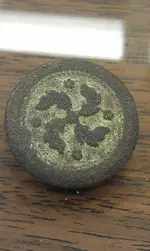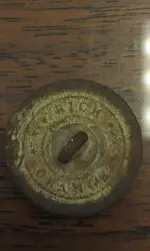You are using an out of date browser. It may not display this or other websites correctly.
You should upgrade or use an alternative browser.
You should upgrade or use an alternative browser.
✅ SOLVED Rich Orange Button help
- Thread starter Tedyoh
- Start date
DCMatt
Gold Member
- Joined
- Oct 12, 2006
- Messages
- 10,472
- Reaction score
- 13,785
- Golden Thread
- 0
- Location
- Herndon Virginia
- Detector(s) used
- Minelab Equinox 600, EX II, & Musketeer, White's Classic
- Primary Interest:
- Metal Detecting
I think Rich Orange is a quality mark. These buttons typically date from the late 1700 to the mid 1800's.
DCMatt
DCMatt
Upvote
0
TheCannonballGuy
Gold Member
- Joined
- Feb 24, 2006
- Messages
- 6,606
- Reaction score
- 13,448
- Golden Thread
- 0
- Location
- Occupied CSA (Richmond VA)
- Detector(s) used
- White's 6000, Nautilus DMC-1, Minelab
- Primary Interest:
- Relic Hunting
DCMatt is correct (as usual), the backmark saying RICH ORANGE is a Quality Rating used by British (and eventually, American) button manufacturing companies, which refers to the quality-level of the goldplating (gilt) or silverplating on these 1-piece brass buttons. In this case, it also refers to the color of the gold gilt. A few of the many other examples are:
Standard Quality (often abbreviated as STANDd -- note the small letter d)
Extra Quality
Superior Quality
Superfine Quality
Fine Gilt
Double Gilt
Treble Gilt
Treble Plated (at that time, "Plated" referred only to silver, not gold)
You asked for time-dating of your button:
Being a brass (not pewter) 1-piece button, with an indented-lettering (not raised-lettering) backmark, and dug in the US (not in Britain/UnitedKingdom or Canada) your button dates from approximately 1810 into the early-1830s. It is most probably British-made, because millions of them were imported here during that time-period, due to the fledging American button-making industry's inability to mass-produce enough to satisfy the demand for them from the clothing-making industry.
Standard Quality (often abbreviated as STANDd -- note the small letter d)
Extra Quality
Superior Quality
Superfine Quality
Fine Gilt
Double Gilt
Treble Gilt
Treble Plated (at that time, "Plated" referred only to silver, not gold)
You asked for time-dating of your button:
Being a brass (not pewter) 1-piece button, with an indented-lettering (not raised-lettering) backmark, and dug in the US (not in Britain/UnitedKingdom or Canada) your button dates from approximately 1810 into the early-1830s. It is most probably British-made, because millions of them were imported here during that time-period, due to the fledging American button-making industry's inability to mass-produce enough to satisfy the demand for them from the clothing-making industry.
Upvote
0
Tedyoh
Bronze Member
- #5
Thread Owner
Thanks Cannon - excuse me for my ignorance on this topic but are you sayng this button once had gold gilt on it and a I assume since i see no gold it wore off?
Also the RICH ORANGE letters are ever so slightly raised, not indented - does this change the age at all.
Thanks in advance.....
Also the RICH ORANGE letters are ever so slightly raised, not indented - does this change the age at all.
Thanks in advance.....
Upvote
0
TheCannonballGuy
Gold Member
- Joined
- Feb 24, 2006
- Messages
- 6,606
- Reaction score
- 13,448
- Golden Thread
- 0
- Location
- Occupied CSA (Richmond VA)
- Detector(s) used
- White's 6000, Nautilus DMC-1, Minelab
- Primary Interest:
- Relic Hunting
About the apparent lack of gold gilt (goldplating) on your excavated brass button:
Since your button's backmark doesn't include the word "double" or "triple" (or "treble"), it most probably had only a single layer of gilt plated onto its brass body. Buttons get handled and shoved through the buttonhole every day, year after year. That rubbing action tends to wear away the thin gold plating.
However, some of the goldplating tends to remain in "recessed" areas on the button (such as the valleys in an emblem) where it was somewhat protected from getting rubbed off. Based on my own experience with digging many buttons like yours at early-1800s sites here in Virginia, and cleaning those buttons, there's a decent chance that with some non-abrasive cleaning, the recessed areas on your button's front would still show some gold gilt.
Opinions vary widely on what are the best methods to non-abrasively clean excavated buttons. I myself prefer soaking them briefly in a 50/50 mix of water and ammonia. I put that mixture in a milkjug's cap, and set the button in it for 2 or 3 minutes. Then remove the button, and gently scrub it with the tip of a toothbrush dipped in the ammonia mixture. (Sometimes the button will need a second short soak to reveal all the gold gilt.) Then I rinse the button thoroughly in the sink with running water and the toothbrush. (Don't forget to put the stopper into the sinkdrain first.)
You also asked:
> the RICH ORANGE letters are ever so slightly raised, not indented - does this change the age at all.
Yes. Your single photo of the button's back doesn't make the raised lettering evident to the eye, so I had to assume it was indented lettering. A raised-lettering backmark on a 1-piece brass flatbutton can be as early as the 1790s. But I should mention that the use of raised lettering in backmarks on 1-piece buttons continued for decades afterward. In fact, even some World War One military 1-piece buttons have a raised-lettering backmark.
Since your button's backmark doesn't include the word "double" or "triple" (or "treble"), it most probably had only a single layer of gilt plated onto its brass body. Buttons get handled and shoved through the buttonhole every day, year after year. That rubbing action tends to wear away the thin gold plating.
However, some of the goldplating tends to remain in "recessed" areas on the button (such as the valleys in an emblem) where it was somewhat protected from getting rubbed off. Based on my own experience with digging many buttons like yours at early-1800s sites here in Virginia, and cleaning those buttons, there's a decent chance that with some non-abrasive cleaning, the recessed areas on your button's front would still show some gold gilt.
Opinions vary widely on what are the best methods to non-abrasively clean excavated buttons. I myself prefer soaking them briefly in a 50/50 mix of water and ammonia. I put that mixture in a milkjug's cap, and set the button in it for 2 or 3 minutes. Then remove the button, and gently scrub it with the tip of a toothbrush dipped in the ammonia mixture. (Sometimes the button will need a second short soak to reveal all the gold gilt.) Then I rinse the button thoroughly in the sink with running water and the toothbrush. (Don't forget to put the stopper into the sinkdrain first.)
You also asked:
> the RICH ORANGE letters are ever so slightly raised, not indented - does this change the age at all.
Yes. Your single photo of the button's back doesn't make the raised lettering evident to the eye, so I had to assume it was indented lettering. A raised-lettering backmark on a 1-piece brass flatbutton can be as early as the 1790s. But I should mention that the use of raised lettering in backmarks on 1-piece buttons continued for decades afterward. In fact, even some World War One military 1-piece buttons have a raised-lettering backmark.
Upvote
0
Tedyoh
Bronze Member
- #7
Thread Owner
You are truly "The Man" on these buttons and many other relics....if there's a non profit or any other organization you'd like to see donations go to please let me know, your efforts and time are much appreciated! (along with the other Pro's here) Thanks!
Upvote
0
TheCannonballGuy
Gold Member
- Joined
- Feb 24, 2006
- Messages
- 6,606
- Reaction score
- 13,448
- Golden Thread
- 0
- Location
- Occupied CSA (Richmond VA)
- Detector(s) used
- White's 6000, Nautilus DMC-1, Minelab
- Primary Interest:
- Relic Hunting
Gregg3131, your brass 1-piece flatbutton with an indented-lettering backmark dates from about 1810 into the 1830s. The backmark has the word "warranted" in it, which at that time was British-speak for "guaranteed"... so your button was almost certainly made in Great Britain.
Upvote
0
Similar threads
- Replies
- 14
- Views
- 707
Users who are viewing this thread
Total: 1 (members: 0, guests: 1)






